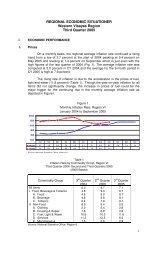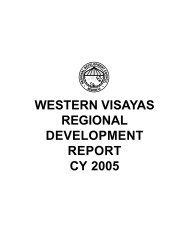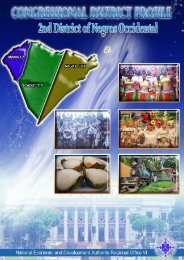Chapter III.pdf - NEDA-RDC VI
Chapter III.pdf - NEDA-RDC VI
Chapter III.pdf - NEDA-RDC VI
You also want an ePaper? Increase the reach of your titles
YUMPU automatically turns print PDFs into web optimized ePapers that Google loves.
Traditional exports will increase from US$13.78 million in 2004<br />
to US$14.63 million in 2010 or a total of US$99.41 million for<br />
the plan period.<br />
Traditional exports include assorted marine products, dried<br />
mangoes, bamboo craft, and ceramic products while nontraditional<br />
exports include commodities of leading industries<br />
such as loomweaving, horticulture, muscovado, gifts, toys and<br />
housewares, and others.<br />
f. A total of 275 technology interventions, 15,831 technology<br />
services and 490 training programs for SMEs will be realized at<br />
the end of the plan period. This will encourage the private sector<br />
to further invest or expand their business.<br />
g. Scholarships for college students will be provided to 3,528 poor<br />
and deserving students by 2010. The focus of studies will be<br />
science and technology.<br />
h. Tourist arrivals are projected to reach 1.02 million in 2004 and<br />
1.73 million in 2010 or a total of 9.44 million for the plan period.<br />
This will result from the intensified promotion of the region’s<br />
tourism sites, natural attractions, and other tourist destinations.<br />
i. With the increase in the number of tourists, tourist receipts will<br />
also increase from Php18.82 billion in 2004 to Php32 billion in<br />
2010. Tourists are expected to stay at an average of 6.3 days<br />
with average daily expenditures for both domestic and foreign<br />
tourists at Php2,918 per person.<br />
j. The number of CARP beneficiaries (with livelihood projects in the<br />
Agrarian Reform Communities) will increase by 34 percent from<br />
2004 to 2010. This will facilitate employment in the ARCs.<br />
k. The number of livelihood projects (in the Agrarian Reform<br />
Communities) will increase by at least 60 percent from 2004 to<br />
2010. Livelihood projects would include swine raising, cattle<br />
raising, food processing, vegetable production, and cottage<br />
industries Rural agro-industries include mat weaving,<br />
loomweaving, vine craft, and others.








